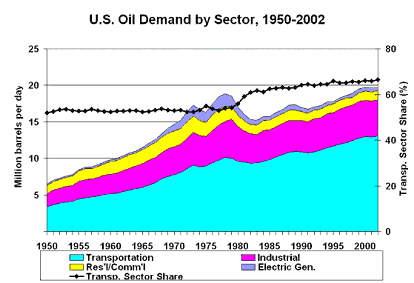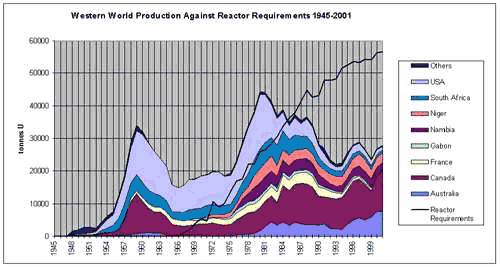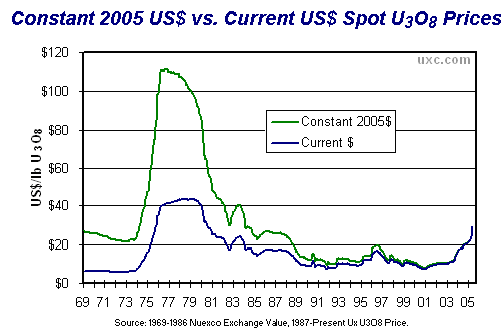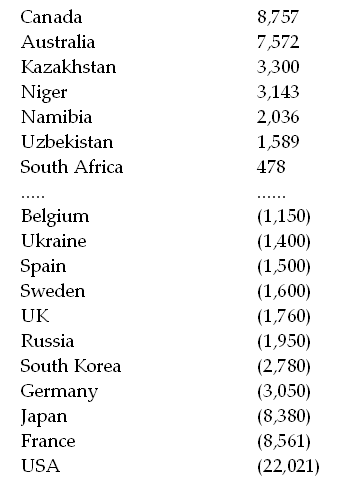|
FRIDAY EDITION December 5th, 2025 |
|
Home :: Archives :: Contact |
 |
ENERGYWritten and published by Warren Pollock pollock.warren@verizon.net from The Macroeconomic Newsletter Editing services by Jeremy Irwin, jc9cz@yahoo.com
January 9th, 2006
It is reasonable to expect that the United States will eventually develop an energy strategy. I posit that the Unites States will soon need to adjust itself to subsist on less oil than it does presently. It is foreseeable that within the next five years, the US will have to reduce its oil use from 20 million barrels of oil a day to 12 million. Transportation is the most readily adjusted component, and the largest (over 50 per cent). The use of petroleum products as vehicle fuels is classified as "transportation" use. In the United States, in contrast to other regions of the world, about two-thirds of all oil use is for transportation. (In most of the rest of the world, oil is more commonly used for space heating and power generation than for transportation.) The use of distillate fuel oil for home heating was once much more prevalent than it now is . . . Jet fuel is the third-highest product in demand and, like gasoline, is largely confined to use in the transportation sector.
-- Department of Energy  The ironic kicker in energy wastage is the current transportation cost curve of suburbia. Using a five-passenger car to carry one person in suburbia makes perfect and absolute economic sense. Mass transit systems worked best in the densely populated peak conditions of yesteryear. It is likely in the near future that passenger cars built to carry five people will be economically forced to carry five. Perhaps minibus services and bus networks will pop up that are similar to those to be found in Hong Kong, Turkey and elsewhere. Transportation fuel has been cheap because there have been few buyers and willing sellers. In terms of margin, a willing nation-state was able to experience a local economic boon by allowing a multinational firm to deplete finite resources. To these caste-ridden nations the dollar was internationally convertible (as good as gold). The internal currency used by the local people . local paper (silver) . was of secondary consideration. The international currency used in calculating costs, sale price, and profits was the US dollar. Global demand for energy has increased while supply growth remains limited. Price in this circumstance has no relevance. Energy has become entirely strategic in nature. Suppliers will soon dictate terms of sale and of payment. Payment might take the form of a strategic relationship. Foolish nations are allowing their energy reserves to deplete, mostly to assuage the potential of near-term local instability. Astute producing nations are hoarding. A few nations with declining reserves are engineering for the future. Stability conscious China has been building relationships conducive to a supply chain. Iran, rich in oil and with nuclear power, looks towards manifest destiny. Mexico has been exporting fuel oil northward and pulling distilled product southward. "I'm ordering the government and Gazprom to conduct gas supplies to Ukraine in the first quarter of 2006 on the terms and at the prices of 2005, if the Ukrainian partners by the end of the day sign a contract proposed by Gazprom to transfer to free-market prices starting from the second quarter," Putin said during a session of the presidential Security Council. Reduced consumption is the only immediate tuning parameter available to the US. Thereafter, uranium is the best option. Nuclear energy has the potential to replace scarce natural gas inputs now used to convert shale and tar sands to refined product. I would like to bring two articles to your attention, “Oil: The illusion of plenty” and “Oil: Caveat Empty” and then talk more about natural gas and uranium. http://www.thebulletin.org/article.php?art_ofn=mj05cavallo http://www.thebulletin.org/article.php?art_ofn=jf04cavallo NATURAL GASIts likely that with the energy crisis of the 1970s and the partial meltdown of the Three Mile Island nuclear plant “facilitated” a rush towards natural gas. Natural gas is a politically beneficial and expedient solution. Natural gas supplies are continental, the fuel burns clean, and it has high efficiency in heating, electricity generation and transportation. The only downside to limitless demand pull is limited supply! In the political world everything needs to burn natural gas. If a power utility conveniently “forgot” to invest in new power plants, no problemo: GE would be happy to ship a clean burning jet engine to any locale. Bus borne asthma and grit plaguing your city? Burn natural gas. When a policy of expediency fails for lack of supply we will cling to our hopes for deep natural gas (15,000 feet underground), tight natural gas (trapped in hard non-porous rock), Devonian shale gas (see the Star Trek Encyclopedia), coal bed methane, geo-pressurized zones (10,000-20,000 feet deep), and methane hydrates. In phase two of hopefulness the Department of Energy will be tasked, over ten years, to build a “clean” coal plant to produce hydrogen. “Today I am pleased to announce that the United States will sponsor a $1 billion, 10-year demonstration project to create the world’s first coal-based, zero-emissions electricity and hydrogen power plant ...”
-- President George W. Bush, February 27, 2003 Closer to reality, in five years we will drive less than we do today, use oil to heat our homes, rely on diesel buses and full cars for transportation, stop shipping fruit and lobster on jet airplanes, and use ultra-scarce natural gas to produce fertilizer and plastics (or use it to generate both electricity and heat in fuel cells). In five years we might – might – see Toshiba’s 4S (Super Safe, Small and Simple) go into production. URANIUMNewsletter writer James Dines was the first independent analyst to rediscover this neglected market. Dines was not alone. In the shadows, people in high places has been thinking ahead regarding uranium; major mines have been snatched up by privately held companies such as General Atomics (Rio Grande Resources Corporation and Heathgate), and acquired by large mining conglomerates such as BHP Billiton (WMC Resources). The chart below shows that uranium demand outstrips supply and will continue to do so into the foreseeable future. Long-term price targets of $100 and then $300 per pound would be reasonable. The current price is less than it was in the 1970s.  Uranium supplies are abundant. Within the United States many mines have been abandoned complete with surveys of accessible mineralization. Again, natural gas might be stuck five and ten thousand feet deep down. The future price of uranium will be a function of thirty years worth of neglect on the supply side. Thereafter, the price will be a function of additional demand. Uranium energy has a role in the production of electricity, steam production, and the making of hydrogen for consumption in fuel cells.  It is interesting to note that sometimes privately held companies have better investment quality than a company traded on an exchange. For example, General Atomics has a presence in defense (predator), fusion, supercomputing, hazardous materials handling, and nuclear fuel. In other words, it’s a mover and shaker with high reaching political connections and ownership. Another interesting private company is SAIC (Science Applications International Corporation), which is employee owned. My point here is that although we might not have the insider access to be players in scale, we have the chance to profit from being a follower, being happy with the grizzle. Spent reactor fuel and decommissioned weapons material can be reprocessed into plutonium-laden MOX, a mix of uranium and plutonium oxides. This refinement process is now old technology. The Bulletin of Atomic Scientists has this to say: “It costs more, it’s as dangerous to make as a bomb, and burning MOX creates almost as much plutonium as it gets rid of. Other than that, it’s a great idea.” The US may start building a MOX plant at Savannah River in 2006. For MOX to make financial sense, uranium prices would need to approach $300 per pound. Investors interested in the uranium story need to look at the major producers and speculative junior companies. A Canadian company, Cameco dominates the uranium mining and processing industry. Areva Corporation (France-Cogema) is the second major player in this field. Areva also processes spent fuel into MOX. Both of these companies are investment worthy. A good strategy would be to purchase small quantities of shares over a long period of time. By slowly dripping money into these two stocks a large position can be accumulated for a long-term hold. The large stocks in this group are highly volatile, it will take time for everyone to latch onto the story. It’s interesting to note that Jim Cramer has latched onto Cameco. Smaller, more speculative companies have a different risk / reward curve. The following stocks make Cameco and Areva look stoic, steady, and less risky. UEX Corporation (UEX.TO): Advanced stage exploration, and relationships with Cameco and Areva SXR Uranium One (SXR.TO): In production in Australia and South Africa. Fronteer Development (FRG.TO): Uranium/ gold projects in Turkey, Mexico and Canada. As highly speculative juniors go, it is best to find those companies with mineral rights on historic reserves and (of course) competent management. Energy Metals (EMC.V): Aggressive acquisition of mining rights and properties. Max Resources (MXR.V): Received the necessary permits from the State of Utah and the US Bureau of Land Management to drill its Thomas Mountain uranium prospect in Juab County. Rodina (RM.V): Leveraging a Westinghouse study. 2003 Uranium Production vs. Requirements Balance (in tonnes of uranium; includes some estimates)http://www.world-nuclear.org/info/inf23.htm 
Written and published by Warren Pollock
January 9th, 2006
This generalized publication seeks to discuss macroeconomics, technical analysis, investing theory,
politics, news and markets. It does not provide specific advice to any individual. It is our
recommendation and opinion that individuals seek the counsel of a licensed financial adviser who can
design a plan appropriate to specific financial conditions, objectives and risk tolerance. The publisher
of this newsletter may purchase, hold, and dispose of positions in financial instruments discussed
herein at will.
Subscriptions are billed at USD 1,450 per calendar year (CAD 1,800 for Canadian residents).
Subscribers will be e-mailed at least 26 issues per year. Newsletters are published to the tempo of
events. Payment can be made either by Paypal (www.paypal.com) to the publisher at
pollock.warren@verizon.net or by check made out and mailed to Warren Pollock at POB 413, Garrison,
NY 10524. |
| Home :: Archives :: Contact |
FRIDAY EDITION December 5th, 2025 © 2025 321energy.com |
|